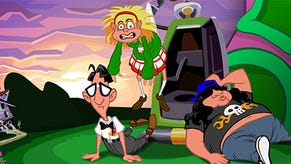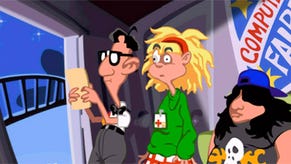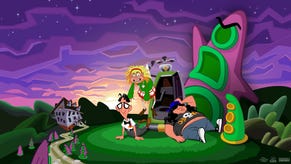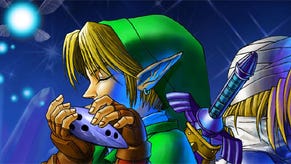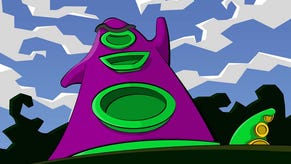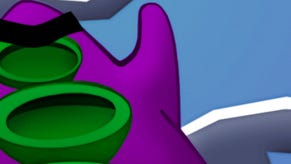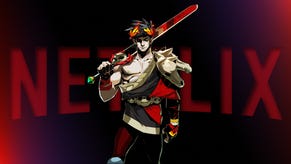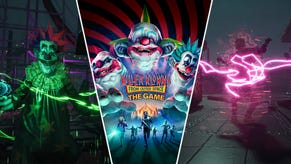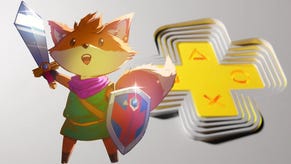Day of the Tentacle Composer Peter McConnell on Communicating Cartooniness
COVER STORY: One of DoTT's trio of musicians talks about the challenges of selling its zany atmosphere with some relatively primitive tools.
This article first appeared on USgamer, a partner publication of VG247. Some content, such as this article, has been migrated to VG247 for posterity after USgamer's closure - but it has not been edited or further vetted by the VG247 team.
USg: So, Day of the Tentacle establishes itself as an interactive cartoon. I think even the box says that in some capacity. And whenever you're making a cartoon in a classical style, the music carries a lot of the responsibility for selling the action, but, again, you're working with limited technology, and you can't always sync up the actions to the music. So, what were some of the challenges of evoking that cartoony spirit with the limitations you had?
PM: The very biggest challenge was the wide variety of playback systems. I mean, Day of the Tentacle had to work on a PCAT, like an 82, 86 chip. I hope I'm remembering these numbers right. When you set up the game, you were still in text mode on a PC. And you had to deal with the fact that some of your audience had a PC that was going to be twice as slow, literally twice as slow, as—One of our biggest fans was Steven Spielberg, and every time we'd do a LucasArts game, we'd get a letter from Steven Spielberg saying how much he loved what we did, which, of course, was very fun. And Steven had, I hope you don't mind I call him Steven, I never met him, he had a full time guy who kept his game computer, at least this was reputed to be true—
USg: I just heard a story that he had a guy who recorded things from American TV to send to him on set, so he seems to have a lot of guys.
PM: As well he should. And so, he had the guy who kept his gaming computer system up to scratch, so I'm sure he had the fastest PC and a killer surround sound system as sure as surround sound was relevant at all, and a great room to play it in. So, we were basically creating games for everybody from Steven Spielberg to play to some college kid who's got a PCAT that they found in a dumpster, and has not even a SoundBlaster, but just an AdLib card. And as a result, things like cutscenes, there's something that you pretty much take for granted in games these days. It's still not 100 percent, but you essentially take fixed framerate for granted. You know if the cutscene takes one minute and four seconds on [somebody's PC] at some college dorm somewhere, you know it's also going to take one minute and four seconds at Steven Spielberg's gaming suite. So, timing is something that's more like the movies now than it was then.
But in those days, no matter what the programmers told you, and they did occasionally try to claim otherwise, there was nothing remotely waving at a fixed framerate. So, one of the things that the iMUSE system did was to compensate for that by playing longer or shorter versions of the piece depending on how things were progressing in a cutscene. It's weird, kind of: iMUSE was kind of famous at that time for being interactive. You do something, and the music does something, and that's sort of exciting. What a lot of people didn't realize that a lot of the heavy lifting done by iMUSE was to just make it seem like it wasn't interactive at all, to make it seem like a movie playing.
So, if you play the opening cutscene, with the purple tentacle and so on, on one person's machine, it would not look or sound exactly the same as on another's, and we wanted to be sure that it was still going to—See, this was before people were playing cutscenes by streaming the video and using a codec, like that. The first LucasArts product to do that, to my knowledge, was Rebel Assault. And Vince Lee, who programmed that, he was the first person at Lucas to rather brilliantly see is what you have to do is sync the picture to the sound and not the other way around.

USg: So, would you say the "improvisational" nature of the soundtrack is a safeguard, in a way, for different kinds of technology?
Yeah, pretty much, I think of Monkey 2, Indy 4 and DoTT as sort of a trio. And they were very much a trio, because they were constant music, that had been the expectation in graphic adventures. Constant music, so, to achieve the constant music without it having the sense of it being a loop, because we really did, we tried to have forms that weren't obviously loops. And, we would look at what other people were doing, too. Sierra Online did versions of this as well, where the music had little modules that would play randomly and give you a sense of, first of there being more music than there was, and just, if you start to play a one minute loop, it's going to be noticeable midway through the second repeat. And that can be pretty mind-numbing if you're—It can work in some situations, like in a combat situation.
But if you're sitting there trying to solve a puzzle, and because DotT was a puzzle game, that's a big reason for that perception you have of the music cruising around, because you want to give a cartoony effect when there are cartoony moments, but when characters are exploring around you want it to be kind of ambient. That was basically what we were going for and spending all our effort on, was to keep a variety and have a sense of the music being musical, and not just being slavish, but at the same time, if something important happened, the music had to be right there.
So, our metaphor was a pit orchestra. I played in a pit orchestra in high school for musicals, and, there's a score that everyone's reading in the pit orchestra, but the conductor's always looking over his shoulder to see what's going on on the stage. And, every so often, it'll be like, “OK, measure 32.” It's usually not that dramatic, but the tempo, whether or not to take a repeat, all those kind of things, those are judgments that the conductor makes based on what's going on on stage, and show music has little pieces that can play while they're waiting for something to happen, like a curtain call or something like that.
